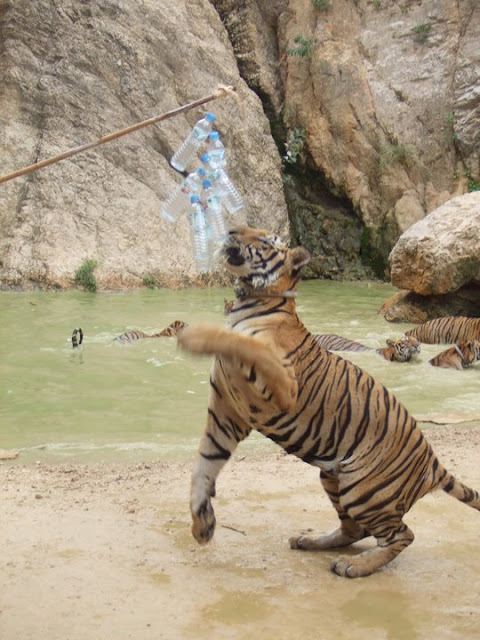12 to 16 Navember 2009
Bandhavgarh National Park Profile
Bandhavgarh National Park lies in the Vindhyan range of Madhya Pradesh and was once the royal hunting ground for the rulers of the by gone era of Rewa. The park extended over an area of 448sq.km is abode of the famous White Tigers of Rewa. In 1951 the legendary White Tigers of Rewa was captured called as Mohan, who supposedly fathered several offspring found in zoos the world over. Mohan is now replete and arrayed in the palace of the Maharaja of Rewa.
Bandhavgarh National Park is an exquisite amalgamation of its wildlife beauty and historic monument Bandhavgarh Fort. The park is largely covered with Sal forest that forms the perfect abode to the diverse variety of wildlife including a large number of tigers.
Treasures of the Wild
Bandhavgarh National Park is an exquisite amalgamation of its wildlife beauty and historic monument Bandhavgarh Fort. The park is largely covered with Sal forest that forms the perfect abode to the diverse variety of wildlife including a large number of tigers.
Treasures of the Wild
Majestic Tiger
Bhandhavgarh National Park enjoys the highest density of tiger population in India. Tigers use to roam nonchalantly here in the great wilds of the park, but due to extensive hunting by Maharaja Venkat Raman Singh, he hunted 111 tigers in his life span, their number came down tremendously. Government has taken immense measures to protect and regenerate this majestic beast without marring the natural charm of the park.
Other Wildlife Attraction
The park is also famous for its langur and rhesus macaque population. There are almost 22 species of mammals includes jackal, bangal fox, bears, mongoose, hyena, jungle cat and leopard forms the core carnivore population. Visitors can often encounter the animals frequently like wild pig, spotted deer, sambar, the small Indian civet, palm squirrel and lesser bandicoot rat while exploring its wilds. The reptilian species include cobras, kraits, vipers and pythons.
Aerial Population in the Park
The park is an abode of 250 species of bird population. The most important among them are- Peacock, Paradise fly catchers, Jungle Fowl, Golden and Black headed Orioles, Yellow Ioras, Red-vented Bulbuls, Blue Jays and include the migratory birds that arrive in winter like the steppe eagle and various water birds.
The Vegetation in the Park
The rich flora of the park includes dry deciduous forests. The park is also embellished with Sal trees. The north of the park is covered with stretches of Bamboo and green meadows. The terrain is rough and roughed, broken with rocky hilly range, extending vigorously east west, disperse with grassy swamps and forested valleys.
Wildlife Safaris
Bandhavgarh National Park facilitates diverse options for wild life safaris. The treasures of wildlife can be explored on a royal ride by taking up elephant safari, jeep and car safari. Jeep safaris can be undertaken during the early morning hours till evening and it helps you to penetrate more deeps into the dense forest of the park where as elephant safari trips are normally organized for tiger tracking early in the morning. A forest department guide always accompanies you in these safaris.
The Best Time to Visit the Park
The best season to visit this park is between November to June. During the monsoon seasons-1st July to 31st October the park remain close. The park can best be viewed early in the morning or after 4 p.m., during this time animals are most astir and can be easily spotted.
Other Attraction
Amidst the Park is erected the ruins of colossal Bandhavgarh Fort built in the 14th century. It is an ancient fort believed to be more then 2000 years old. There are many caves found in the Fort native to the pre-historic period with Brahmi engravings dating far back to the first century BC.
Mode of Transport
Air: The nearest airport is that of Khajuraho 230-kms connected to the flights from all over India. From Khajuraho, it takes just five hours by road to reach the national park.
Rail: The park can be approached through number of railheads. The main railway station is Jabalpur just 164 km away from the park. Katni railhead is-102 km, Satna- 117 km on the central railway sections. Umaria-35 km falls on the southeastern section of the railways. Therefore it become quite easier to reach Bandhavgarh.
Road: Bandhavgarh is also well connected by means of road transport, it is the center point from the city of Jabalpur and world famous erotic temples of Khajuraho. The park can be accessed by traveling on any of these roads.
 |
| Chital Stag |
 |
| Blue Cheeked Bee Eater |
 |
| Chital Stag |
 |
| Indian Jackal |
 |
| Indian Roller |
 |
| Indian Roller |
 |
| Indian Roller in Flight |
 |
| Langar Monkey |
 |
| Langar Monkey |
 |
| Langars |
 |
| Masque With Pale Colored Eyes |
 |
| Macque |
 |
| Munjac Deer |
 |
| Peacock Displaying For Females |
 |
| Samba Deer |
 |
| Samba Deer |
 |
| Serpent Eagle |
 |
| Thicknee On Her Nest |
 |
| Tiger In The Grass! She's Turned Her Ears Back In Just The Way My Domestic Cat "Sudu" Does When She's Pretending To Be Disinterested But Listening To Every Where. |
 |
| Tigress She Has a Badly Injured Rear Right Paw Which Causes Her To Limp Badly.Despite This 9 Month Old Injury Has Successfully Hunted and Rear.... |
 |
| White Fronted Kingfisher |
 |
| Wild Boar Make a Run Of It |







































































































